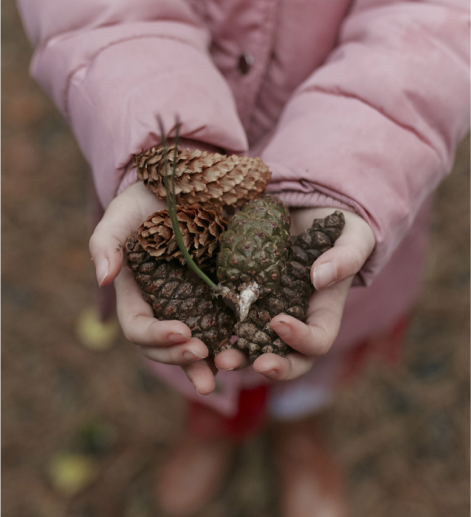The National Parks run lots of nature inspired workshops and events throughout the year. With a strong focus on conservation, biodiversity and sustainability, there are events tailored to all ages and interests.
Family focused events include: guided walks, nature trails, nature-inspired art competitions, insect hunts, birdspotting challenges, and many more. Guided walks and hikes take place across all the parks, in addition to park-specific events such as stargazing in Wild Nephin, and regular nature based walks, talks and workshops in Glenveagh.
Species Mammal
25
Species Bird
400
Species Insect
12,000+
Species Plant
4,000
EXPLORE THE NATIONAL PARKS







Where nature speaks
01 / ETHOS
Discover Ireland’s National Parks and experience the beauty of nature up close.
National Parks are guardians of Ireland’s unique geography and ecology to preserve nature for future generations. While visiting the parks it is important to remember that these environments should be treated with appropriate respect, and their importance honoured.
OUR PURPOSE
Step closer to nature. Step closer to Ireland’s timeless glacier-formed landscapes and habitats pulsating with life, where nature speaks directly in its own voice.
Now, more than ever, we must listen to this voice — nature’s voice — in our National Parks.
02 / Our goals
-
Goal 01
To protect and conserve nature for future generations
-
Goal 02
To be leaders in conservation education in Ireland
-
Goal 03
To instill a sense of pride and respect for nature in all who visit the parks
03 / NATIONAL PARKS
Our National Parks
Ireland’s National Parks provide unique opportunities to be at one with nature; the purest of experiences in nature giving emotions of awe, wonderment, feelings of connectedness and peacefulness.
In every walk with nature one receives far more than he seeks.
John Muir
04 / Nature Reserves
Our Nature Reserves
A Nature Reserve is a protected area of importance to wildlife. Ireland has 77 registered nature reserves that all play an integral role in preserving nature for future generations. Most are owned by the State, but some are owned by organisations or private landowners.
Find a nature reserve
Leinster
Baldoyle Estuary Nature Reserve
North Bull Island Nature Reserves
Rogerstown Estuary Nature Reserve
Pollardstown Fen Nature Reserve
Ballykeeffe Wood Nature Reserve
Fiddown Island Nature Reserve
Garryricken Woods Nature Reserve
Kyledohir Wood Nature Reserve
Coolacurragh Wood Nature Reserve
Grantsown Wood and Granston Lough Nature Reserve
Slieve Bloom Mountains Nature Reserve
Timahoe Esker Nature Reserve
Newcastle Lough, private Nature Reserve
Clara Bog Nature Reserve
Mongan Bog Nature Reserve
Raheenmore Bog Nature Reserve
Slieve Bloom Mountains Nature Reserve
Scragh Bog Nature Reserve
Ballyteigue Burrow Nature Reserve
The Raven Nature Reserve
Wexford Wildfowl Reserve
Deputy’s Pass Nature Reserve
Glen of the Downs Nature Reserve
Glendalough Nature Reserve
Glenealo Valley Nature Reserve
Knocksink Wood Nature Reserve
Vale of Clara Nature Reserve
Munster
Ballyteigue Nature Reserve
Caher (Murphy) Nature Reserve
Dromore Nature Reserve
Keelhilla (Slieve Carron) Nature Reserve
Capel Island and Knockadoon Head Nature Reserve
Glengarriff Woods Nature Reserve
Kilcolman Bog Nature Reserve
Knockomagh Wood Nature Reserve
Lough Hyne Nature Reserve
The Gearagh Nature Reserve
Cummeragh River Bog Nature Reserve
Derrycunnihy Wood Nature Reserve
Derrymore Island
Eirk Bog Nature Reserve
Great Skellig Nature Reserve
Little Skellig Nature Reserve
Lough Nambrackdarrig Nature Reserve
Lough Yganavan Nature Reserve
Mount Brandon Nature Reserve
Puffin Island Nature Reserve
Sheheree Bog Nature Reserve
Tearaght Island Nature Reserve
Tralee Bay Nature Reserve
Uragh Wood Nature Reserve
Redwood Bog Nature Reserve
Connacht
Clochar na gCon/Bealacooan Bog Nature Reserve
Coole Park Nature Reserve
Derryclare Nature Reserve
Derrycrag Wood Nature Reserve
Leam West Bog Nature Reserve
Pollnaknockaun Wood Nature Reserve
Richmond Esker Nature Reserve
Rosturra Wood Nature Reserve
Knockmoyle Sheskin Nature Reserve
Oldhead Wood Nature Reserve
Owenboy Nature Reserve
Ballygilgan (Lissadell) Nature Reserve
Easkey Bog Nature Reserve
Union Wood Nature Reserve
Ulster
Ardnamona Nature Reserve
Ballyarr Wood Nature Reserve
Derkmore Wood Nature Reserve
Duntally Wood Nature Reserve
Inch Levels Wildfowl Reserve
Lough Barra Bog Nature Reserve
Meenachullion Nature Reserve
Pettigo Plateau Nature Reserve
Rathmullen Wood Nature Reserve
Sheskinmore Nature Reserve
Protect
Nature
05 / Protect Nature
National Parks inspire visitors to create their own experiences and journeys, where they feel rejuvenated and restored, with a greater understanding of conservation and care.
Now, more than ever, we must listen to this voice — nature’s voice — in our National Parks.
01 / Think about the best time to visit and how you’ll travel here, to minimise your environmental impact.
02 / Respect wildlife and always keep your dogs on a lead.
03 / Leave what you find and do not disturb the flora and fauna.
04 / Dispose of waste properly, litter is a huge threat to nature.
A Place to Learn









